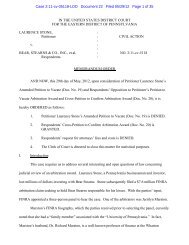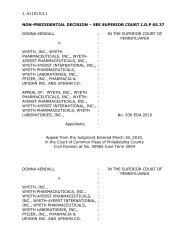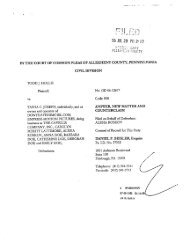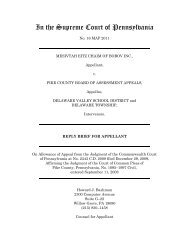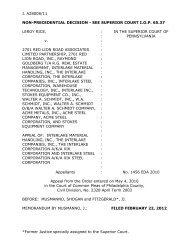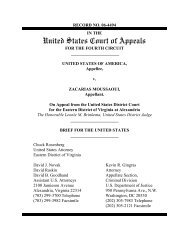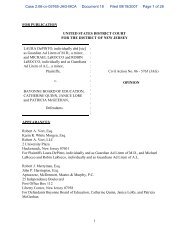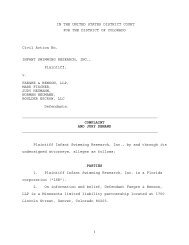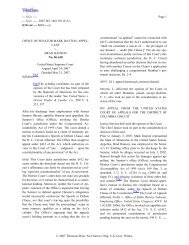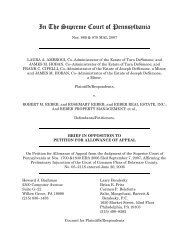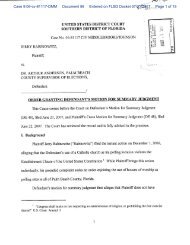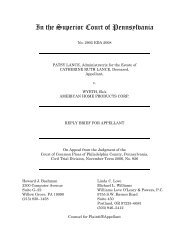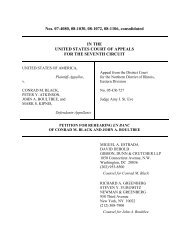In the Superior Court of Pennsylvania - How Appealing
In the Superior Court of Pennsylvania - How Appealing
In the Superior Court of Pennsylvania - How Appealing
Create successful ePaper yourself
Turn your PDF publications into a flip-book with our unique Google optimized e-Paper software.
The results <strong>of</strong> <strong>the</strong> WHI received widespread attention from <strong>the</strong> popular<br />
media. By way <strong>of</strong> example, <strong>the</strong> National Cancer <strong>In</strong>stitute <strong>of</strong> <strong>the</strong> NIH (“NCI”)<br />
reported <strong>the</strong> groundbreaking nature <strong>of</strong> <strong>the</strong> WHI study’s results as follows:<br />
Hormone <strong>the</strong>rapy, ei<strong>the</strong>r estrogen alone or estrogen combined with<br />
progestin, has been <strong>the</strong> subject <strong>of</strong> numerous studies over <strong>the</strong> past two<br />
decades. Some <strong>of</strong> <strong>the</strong> findings have suggested benefits to hormone use;<br />
o<strong>the</strong>rs have suggested risks.<br />
Recently, however, one definitive study has convinced experts that <strong>the</strong><br />
risks <strong>of</strong> estrogen plus progestin outweigh <strong>the</strong> benefits. This large<br />
randomized trial, conducted as part <strong>of</strong> <strong>the</strong> Women’s Health <strong>In</strong>itiative<br />
(WHI) at <strong>the</strong> National <strong>In</strong>stitutes <strong>of</strong> Health, was stopped early when it<br />
became clear that estrogen plus progestin increased <strong>the</strong> risk <strong>of</strong> heart<br />
disease, blood clots in <strong>the</strong> legs and lungs, and breast cancer.<br />
See Summary <strong>of</strong> <strong>the</strong> Evidence <strong>of</strong> <strong>the</strong> Risks and Benefits <strong>of</strong> Postmenopausal Use <strong>of</strong><br />
Hormones, BenchMarks (Aug. 20, 2002) (available online at: http://www.cancer.gov/<br />
newscenter/archive/benchmarks-vol2-issue8/page2). The NCI explained that “[t]he<br />
highest level <strong>of</strong> evidence for a causal association between hormone exposure and<br />
disease or condition is achieved with a randomized, controlled, blinded, clinical<br />
trial,” which is <strong>the</strong> very type <strong>of</strong> study that <strong>the</strong> WHI represented. Id.; see also<br />
R.1706a–07a (“The WHI proved definitively what 30 earlier studies could not: HRT<br />
does indeed raise <strong>the</strong> risk <strong>of</strong> developing invasive breast cancer.”).<br />
C. The relevant facts and procedural history <strong>of</strong> <strong>the</strong>se consolidated<br />
cases<br />
Plaintiffs claim that E+P caused <strong>the</strong>ir breast cancer. While it is true that<br />
each plaintiff commenced her suit more than two years after receiving her breast<br />
cancer diagnosis, each sued within two years <strong>of</strong> <strong>the</strong> publication <strong>of</strong> <strong>the</strong> WHI study’s<br />
results on July 9, 2002. Plaintiffs thus sued within two years from <strong>the</strong> date on<br />
– 10 –



